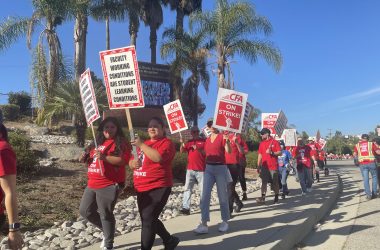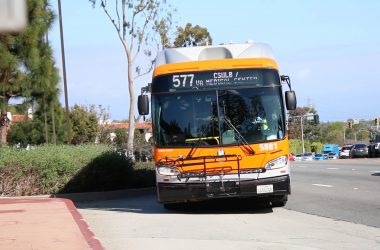More than 100 students and members of organizations representing university workers voiced their frustrations at with the budget outside the Office of the Chancellor in Downtown Long Beach on Tuesday.
More than 100 students and members of organizations representing university workers voiced their frustration at with the budget outside the Office of the Chancellor in Downtown Long Beach on Tuesday.
Inside, the board of trustees discussed the 2009-10 budget and declare the system impacted.
Projections of a current $11.2 billion state budget shortfall and an expected shortfall of $24 billion next year has lead CSU Chancellor Charles Reed to declare the system impacted for the first time in its history.
The chancellor’s declaration of impaction means the CSU will be admitting 10,000 fewer students for the 2009-10 school year by means of moving up application deadlines, upping admission criteria and giving local students priority over out-of-area students.
“Access without quality is meaningless,” said trustee Herbert Carter in a conference call on Monday, “and we can’t have access unless we have the level of funding that is required to support the educational aspirations of the people in this state.”
But with California’s unemployment rates having risen for seven consecutive months, declining consumer spending and drops in property taxes as a result of home foreclosures, the prospects of securing greater funding for heightened access are tough, said Robert Turnage, assistant vice chancellor of budget for the CSU.
Outside the meeting, students voiced concerns about the future of their education, and faculty and staff members vocalized their opinions about wages and benefits.
Lauren Romero, a sophomore Chicano studies major from CSU Dominguez Hills, said that she came out to rally on behalf of herself and her five brothers and two sisters.
“I want them to come to a Cal State,” she said. “I don’t want them to get denied like the 10,000 other students that are being denied.”
“I’m here to save or salvage my education,” said Rachel Hassna, a senior student from Cal State Monterey Bay. “I came from a single-parent household and my dad is a hard worker, paying taxes into our public educational system, which is under attack right now. And, for me, the CSU, which primarily educates children of the working class, women and minorities — I represent all of that so that’s why I’m here.”
“In order to save our economy, educating Californians is what’s going to pay off in the long term,” Hassna said. “For every dollar that’s spent on a CSU campus, $4.50 is generated in local economic activity, so a cut to the budget doesn’t make any sense.”
Senior director of external relations for the CSU, Jorge Haynes, explained that he understood that people are angry about the current budget, but that there isn’t a quick solution in sight.
“I think right now the board is dealing with cuts, and anytime you’re dealing with a reduction in dollars you have to be looking at reducing the cost of operations,” Haynes said. “Right now there’s some groups that are diligently trying to pursue salary increases and benefit increases, and it looks to us, given what we know today, that it’s not going to be possible to do that next year.”
Haynes said that although the sharing of personal stories of students, like those of Romero and Hassna effectively gives a more of a face to the cause, it doesn’t mean the economic hardships facing the legislature will go away..
“I think facts are important, but nothing moves our body of politic like human interest stories,” Haynes said. “To put faces on the folks who are not going to be able to access university education, put faces on the folks who are working very hard day in and day out, the 44,000 employees of the CSU, I think it makes a more persuasive case. But that’s not to diminish the incredible obstacles that the legislature and the governor are facing. We, California, just like the rest of the country and, in fact, just like the rest of the world, is in big trouble right now and we’re probably looking at at least a year or two before we can recover from this.”
David Bradfield, the associate vice president of the California Faculty Association, south, and the chapter president at CSU Dominguez Hills for the College Faculty Association (CFA), helped organize the Alliance for the CSU for rally outside the board of trustees meeting and spoke to the crowd about the current and ongoing situation.
“We’ve been suffering cuts for a long time. It’s been particularly egregious since 2001. We already know the cuts are having consequences on every campus,” Bradfield said. “So what we wanted to do today was put a personal face on that and have students, staff and faculty, from San Diego to Humboldt, talk about the impact the cuts have been having, are having, will have.”
Trustee Raymond Holdsworth Jr. urged Turnage to present the budget in a way that emphasizes how the state, in the long run, will be shortchanged if the CSU is continually asked to make millions of dollars in cuts, and to present it as a quality of life issue.
“We really need to tell the story of the linkage to the economy,” Holdsworth said.
He said he thinks the governor’s office lacks “a good grasp on … how the whole economics of how these things work.”
In Monday’s conference call with CSU officials, Lt. Gov. John Garamendi said as much as 50 percent of engineers, 65 percent of teachers and 80 percent of nurses in California come out of the CSU system.
“The Cal State University is one of the work horses of the economy,” Turnage said. “It’s the biggest contributor to the workforce in the state.”




